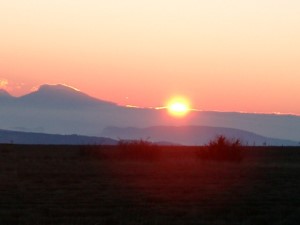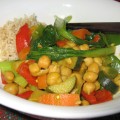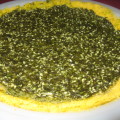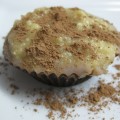

I live in the desert where the average temperature throughout the summer months is 105F. I also train for sprint triathlons and running races but can’t stand gyms. This leaves one option: figure out how to do it all outdoors without feeling terrible!
There are three elements to successful warm weather activity that apply to all people: heat acclimation, proper hydration and wise fuel choices. In addition to this, Vegans need to know what foods will help them achieve their fitness goals while not compromising their lifestyle choices.
Heat Acclimation: Be Wise, Choose Cooling Foods
From a physiological standpoint, you encounter the most severe stress when you exercise in the heat. This is because you must deal not only with the heat from the environment but you’re also generating your own heat. It takes anywhere from 7-14 days for your body to adjust and in the meantime, it’s not going to be all that enjoyable. Get up and out the door as early as possible, especially before the sun is overhead. Expect to go shorter distances at a slower pace and afterwards you may feel more tired than usual (but this improves once you’ve acclimated so don’t give up)*. Also, light clothes and shade help but also spritzing water on your face (or dumping water down your head when you’re especially impassioned) will make you feel better but don’t replace this with ingesting liquid. Your calorie and carbohydrate needs also increase and so will your need to replenish electrolytes so be mindful of this when choosing post-workout nutrition. Also, choosing foods that have a cooling effect rather than a warming effect on the body is a great tool and it really does make a difference.** Here are some examples:
Watermelon(or any other high water content fruit or vegetable), Citrus Fruits, Summer Squash, Dill, Parsley, Mung Beans, Leafy Vegetables, Sea Vegetables, Brown or White Rice, Sprouts, Chia Seeds, Rice Milk
I’ve discussed chia seeds in great detail in the past but it’s worth mentioning that Chia Fresca, the traditional Mexican drink, is an excellent choice for warm weather activity. Here’s the recipe.
Chia Fresca
2 teaspoons chia seeds
16 ounces of pure water
Juice of one lemon or lime
Agave syrup, to taste
- Stir all ingredients together and drink right away (or make ahead of time and stick in the fridge, but if you do this the drink will become slightly gelatinous).
- Great to drink before, during or after exercise.

Drink Sweat Drink Drink
Once the temperature outside begins to rise and your body attempts to acclimate, you can expect to begin sweating faster and in greater amounts. Dehydration results if you don’t take in enough fluids to keep pace with your sweat loss. Losing as little as 2% of your body weight through sweat causes your heart rate to increase, your body temperature to rise and your performance begins to suffer. And from there, it only gets worse. Generally speaking, your body’s natural ability to detect thirst works very well under normal circumstances and in this situation you can trust that mechanism but not in hot weather where the thirst mechanism fails to keep up with the actual fluid needs of our bodies. Here are some general guidelines
- Drink water before any activity but do not overdue it. Humans do not have an extra reservoir for water storage so you cannot effectively “hyper-hydrate” yourself. In other words, your body will just get rid of the extra in the bathroom if you try doing this the night before. Also, drinking too much water will make you feel uncomfortable. In the morning especially just after rising, you will need to replenish the fluids lost during sleep. If your activity is later in the day then make sure and drink sips of water or other fluids throughout the day.
- To measure how much fluid you’re losing during an activity, take a tip from endurance racers and weigh yourself before and after. For every pound lost, drink 2.5 cups of water or other electrolyte drink (not caffeine or alcohol).
- As your body acclimates to the heat, it tends to sweat less. This does not mean you need less fluid though, a mistake often made by rookies. When exercising in heat, put yourself on a drinking schedule: Take several gulps every 15-20 minutes. If you’re with a buddy, then help each other out with this by keeping tabs on one another. If you’re exercising for more than 45 minutes to an hour, then also drink an electrolyte fluid replacement.
Pre-Workout Foods
In the summer months, exercising outdoors is best early in the morning but this also means that breaking your fast needs to be with foods that will give your body an immediate source of energy. The best choice when eating within an hour of exercise is fruit, a simple carbohydrate source that also will hydrate the body and will not cause you to feel sluggish. Beyond this, Medjool dates are also an excellent choice which is rich is glucose (this simple carbohydrate goes straight to the liver for immediate energy). Some athletes utilize energy gels for pre-workout fuel which is also a quick energy source but make sure and drink water with it.
Post-workout foods: Timing IS Everything
Rigorous activity (especially when lasting more than one hour) will deplete your glycogen stores and to a certain degree muscle-bound protein (depending on how long and how hard you workout is). There is a whole science behind sports nutrition that is simply too extensive to cover here but basically for exercise lasting more than one hour you need to consume .5-.75 grams of carbohydrate/pound of body weight (or if you’re not into getting too specific, then shoot for about 50 grams). I mentioned earlier that heat increases your carbohydrate and calorie needs so I would go with the higher end of the range during the summer months. Also, consuming most of this within 30-45 minutes after exercise (referred to as the Fuel Window) promotes the repair the damaged muscle fibers so your recovery rate will be much faster AND you’ll feel much better. Now here’s the trick…intense of exhaustive exercise in the heat depresses the appetite, so eating might be the very last thing you’ll want to do. In this case, once again, don’t rely on your body for natural cues. Ingesting carbohydrate in liquid form is easier on the mind and body, such as a sports drink or a high water content-based fruit. While in the Fuel Window, consume very little fat and protein and No fiber. Also, try eating some of the cooling foods mentioned earlier and again, make a plan ahead of time. Here are some ideas:
Smoothies (containing spinach or kale, coconut or rice milk, chia, flax or hemp seeds and fruit)
Bagel with jam
Banana with fig bars
Baked Potato (cooled ahead of time, sliced and sprinkled with some sea salt)
Cornflakes with rice milk and fruit
Chia Fresca
Japanese sticky rice balls wrapped in seaweed
Frozen grapes
An hour or two after exercise is the time to eat a well-balanced meal containing more protein and fat and complex carbohydrate.
Simply put, exercising in the heat is doable with careful planning as well as allowing your body to adjust to the new demands which takes time and patience. But I’ll tell you that even for a desert rat like myself, it’s worth the effort. You’ll never see a sunrise over a vast open sky if you’re on a treadmill.
*If you haven’t been exercising and are contemplating starting something up this month (like running outdoors for instance) then you might want to reconsider that plan. Heat acclimation should not be combined with a brand new high impact activity and as always, consult a physician beforehand.
Resources
- **Food Energetics is a field of science exploring the properties and benefits of food beyond its basic nutritional components. For more information, go to http://www.stevegagne.com/
- Endurance Sports Nutrition, 2nd Edition by Suzanne Girard Eberle MS, RD
- The Triathlete’s Training Bible, 3rd Edition by Joel Friel
- The Thrive Diet by Brendan Brazier
- The Chia Seed Cheat Sheet and 10 Chia Seed Recipes by Angela Stokes, January, 2008 http://www.naturalnews.com/022468.html
by Melissa Sanborn of Nutritional Brands, PureVegan






1 Comment
Chia (324 comments)
July 6, 2012 at 6:55 amThanks for sharing this. Some common sense and good suggestions.